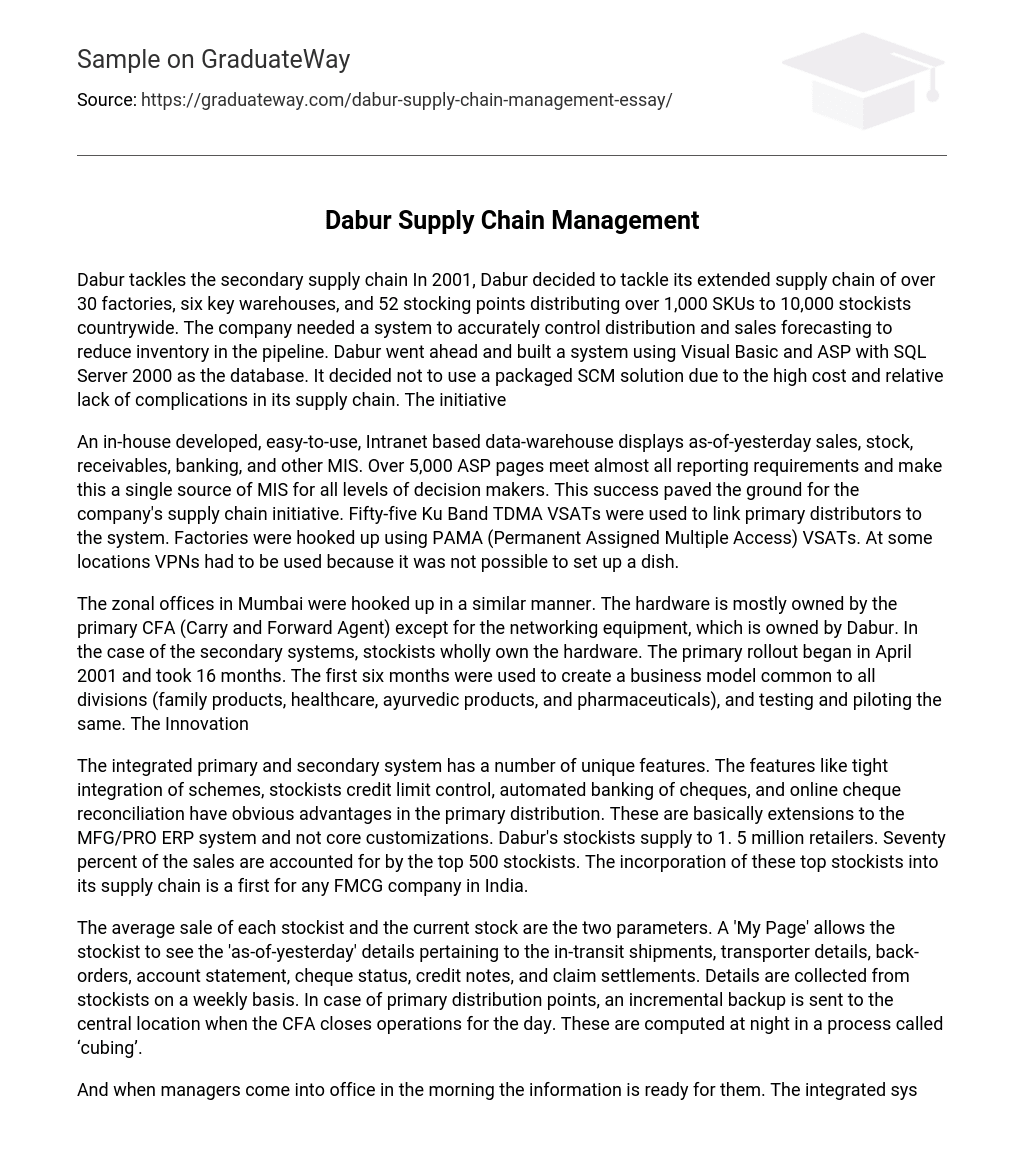Dabur tackles the secondary supply chain In 2001, Dabur decided to tackle its extended supply chain of over 30 factories, six key warehouses, and 52 stocking points distributing over 1,000 SKUs to 10,000 stockists countrywide. The company needed a system to accurately control distribution and sales forecasting to reduce inventory in the pipeline. Dabur went ahead and built a system using Visual Basic and ASP with SQL Server 2000 as the database. It decided not to use a packaged SCM solution due to the high cost and relative lack of complications in its supply chain. The initiative
An in-house developed, easy-to-use, Intranet based data-warehouse displays as-of-yesterday sales, stock, receivables, banking, and other MIS. Over 5,000 ASP pages meet almost all reporting requirements and make this a single source of MIS for all levels of decision makers. This success paved the ground for the company’s supply chain initiative. Fifty-five Ku Band TDMA VSATs were used to link primary distributors to the system. Factories were hooked up using PAMA (Permanent Assigned Multiple Access) VSATs. At some locations VPNs had to be used because it was not possible to set up a dish.
The zonal offices in Mumbai were hooked up in a similar manner. The hardware is mostly owned by the primary CFA (Carry and Forward Agent) except for the networking equipment, which is owned by Dabur. In the case of the secondary systems, stockists wholly own the hardware. The primary rollout began in April 2001 and took 16 months. The first six months were used to create a business model common to all divisions (family products, healthcare, ayurvedic products, and pharmaceuticals), and testing and piloting the same. The Innovation
The integrated primary and secondary system has a number of unique features. The features like tight integration of schemes, stockists credit limit control, automated banking of cheques, and online cheque reconciliation have obvious advantages in the primary distribution. These are basically extensions to the MFG/PRO ERP system and not core customizations. Dabur’s stockists supply to 1. 5 million retailers. Seventy percent of the sales are accounted for by the top 500 stockists. The incorporation of these top stockists into its supply chain is a first for any FMCG company in India.
The average sale of each stockist and the current stock are the two parameters. A ‘My Page’ allows the stockist to see the ‘as-of-yesterday’ details pertaining to the in-transit shipments, transporter details, back-orders, account statement, cheque status, credit notes, and claim settlements. Details are collected from stockists on a weekly basis. In case of primary distribution points, an incremental backup is sent to the central location when the CFA closes operations for the day. These are computed at night in a process called ‘cubing’.
And when managers come into office in the morning the information is ready for them. The integrated system allows each Area Manager to plan for the month’s sales forecasts, stockists performance, and sales officers’ performance. The integration allows better control on pipelines in primaries and secondaries, brings down inventories, and offers better control on production and sales against a confirmed forecast. “The company has added an SMS interface that lets authorized phones query the system for aspects like stock status, credit limits, current outstanding and division-wide sales.
An access control list of mobile phone numbers is used to restrict access to the system. Salespeople can get responses to their queries in a minute with this system,” said Gopal Shukla, Chief Information Officer, Dabur India Limited. The problems The Internet connectivity had to be provided to secondary stockists and wasn’t always reliable. Dabur’s solution was to offer the option of downloading software, working offline, and connecting later to send in updates. Power was another issue. The company laid down stringent standards.
Every stockist had to have an UPS, and in cases where the power shortages are chronic, a genset. The Benefits By integrating its primary and secondary supply chains, Dabur intends to reduce the days of inventory carried in the pipeline by four days from the present 29 days. It aims to save Rs 5 crore by means of this system. Beyond this, the system lets it forecast seasonal spikes in sales and manufacture accordingly. The aim is to shift focus to the stockists rather than the CFAs to get a true picture of what’s happening in the market and react faster.
Future Roadmap Schemes based on secondary volumes will help control secondary pipelines and sales. Primary sales will therefore come from a resultant ‘pull’ from secondary replenishments. Sales order servicing can be further improved by taking orders through the Internet, and by setting stocking norms and replenishing stocks to improve ROI of stockists. Sales officers’ targets can be set against a measure of secondary sales and pipelines to further improve control and avoid stuffing of CFAs to meet targets.





